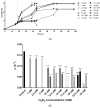Carotenoids as a Protection Mechanism against Oxidative Stress in Haloferax mediterranei
- PMID: 33137984
- PMCID: PMC7694103
- DOI: 10.3390/antiox9111060
Carotenoids as a Protection Mechanism against Oxidative Stress in Haloferax mediterranei
Abstract
Haloarchaea are extremophilic microorganisms that in their natural ecosystem encounter several sources of oxidative stress. They have developed different strategies to cope with these harsh environmental conditions, among which bacterioruberin production is a very notable strategy. Bacterioruberin (BR) is a C50 carotenoid synthesized in response to different types of stress. Previous works demonstrated that it shows interesting antioxidant properties with potential applications in biotechnology. In this study, Haloferax mediterranei strain R-4 was exposed to different concentrations of the oxidant compound H2O2 to evaluate the effect on carotenoid production focusing the attention on the synthesis of bacterioruberin. Hfx. mediterranei was able to grow in the presence of H2O2 from 1 mM to 25 mM. Cells produced between 16% and 78% (w/v) more carotenoids under the induced oxidative stress compared to control cultures. HPLC-MS analysis detected BR as the major identified carotenoid and confirmed the gradual increase of BR content as higher concentrations of hydrogen peroxide were added to the medium. These results shed some light on the biological role of bacterioruberin in haloarchaea, provide interesting information about the increase of the cellular pigmentation under oxidative stress conditions and will allow the optimization of the production of this pigment at large scale using these microbes as biofactories.
Keywords: H2O2; archaea; bacterioruberin; haloarchaea; hydrogen peroxide; oxidative stress.
Conflict of interest statement
The authors declare that the research was conducted in the absence of any commercial or financial relationships that could be construed as a potential conflict of interest.
Figures





Similar articles
-
Haloferax mediterranei Cells as C50 Carotenoid Factories.Mar Drugs. 2021 Feb 10;19(2):100. doi: 10.3390/md19020100. Mar Drugs. 2021. PMID: 33578828 Free PMC article.
-
Optimization of Growth and Carotenoid Production by Haloferax mediterranei Using Response Surface Methodology.Mar Drugs. 2018 Oct 9;16(10):372. doi: 10.3390/md16100372. Mar Drugs. 2018. PMID: 30304770 Free PMC article.
-
Carbon Source Influences Antioxidant, Antiglycemic, and Antilipidemic Activities of Haloferax mediterranei Carotenoid Extracts.Mar Drugs. 2022 Oct 24;20(11):659. doi: 10.3390/md20110659. Mar Drugs. 2022. PMID: 36354982 Free PMC article.
-
Carotenoids from Haloarchaea and Their Potential in Biotechnology.Mar Drugs. 2015 Aug 25;13(9):5508-32. doi: 10.3390/md13095508. Mar Drugs. 2015. PMID: 26308012 Free PMC article. Review.
-
Bacterioruberin: Biosynthesis, Antioxidant Activity, and Therapeutic Applications in Cancer and Immune Pathologies.Mar Drugs. 2024 Apr 9;22(4):167. doi: 10.3390/md22040167. Mar Drugs. 2024. PMID: 38667784 Free PMC article. Review.
Cited by
-
Optimized production of bacterioruberin from "Haloferax marinum" using one-factor-at-a-time and central composite design approaches.Bioresour Bioprocess. 2024 Dec 19;11(1):111. doi: 10.1186/s40643-024-00834-9. Bioresour Bioprocess. 2024. PMID: 39699698 Free PMC article.
-
Haloferax mediterranei Cells as C50 Carotenoid Factories.Mar Drugs. 2021 Feb 10;19(2):100. doi: 10.3390/md19020100. Mar Drugs. 2021. PMID: 33578828 Free PMC article.
-
Genomic and taxonomic characterization of Niallia pakistanensis sp. nov. NCCP-28T: a novel antibiotic-resistant and heavy-metal-tolerant bacterium isolated from the legume rhizosphere in Pakistan.Antonie Van Leeuwenhoek. 2025 Jul 23;118(9):122. doi: 10.1007/s10482-025-02132-6. Antonie Van Leeuwenhoek. 2025. PMID: 40702293
-
Genomic analysis of heavy metal-resistant Halobacterium salinarum isolated from Sfax solar saltern sediments.Extremophiles. 2022 Jul 16;26(2):25. doi: 10.1007/s00792-022-01273-0. Extremophiles. 2022. PMID: 35842547 Free PMC article.
-
Bioactive molecules from haloarchaea: Scope and prospects for industrial and therapeutic applications.Front Microbiol. 2023 Mar 31;14:1113540. doi: 10.3389/fmicb.2023.1113540. eCollection 2023. Front Microbiol. 2023. PMID: 37065149 Free PMC article. Review.
References
Grants and funding
LinkOut - more resources
Full Text Sources

